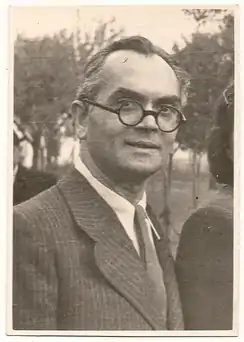
Leonard Rotter (September 14, 1895, Vienna-Floridsdorf - July 14, 1963, Prague) was a Czech sculptor, woodcarver, and watercolour painter.[1][2]
He is not identical with the landscape painter who signed as L. B. Rotter from Uherské Hradiště, whose oil paintings are often presented in auctions under the identity of Leonard Rotter.
Biography
Early life
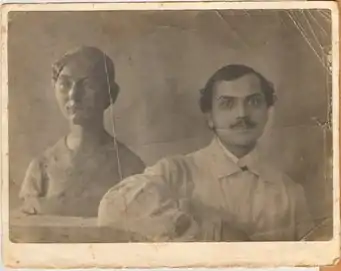
Leonard (Leonhard) Rotter was born on September 14, 1895, in Floridsdorf (Austria), which later became a part of Vienna, to Leonhard and Albine Rotter. In 1900, the family moved to Prague (Czech Republic). He was trained as a woodcarver by František Liška (1909—1912) and later studied at the State Technical School in Prague under professors Jan Maudr and Alois Bouda. In 1914—1917 he studied sculpture at the School of Applied Arts in Prague under the guidance of professors Ludvík Wurzel, Štěpán Zálešák, and Josef Drahoňovský, where he focused on portraits and busts.
From World War I to World War II
During the First World War, Leonard Rotter was seriously injured as a soldier and his injury left permanent nerve consequences. After the end of the war he returned to Prague to continue in sculpture art. He started to work independently, initially in a provisional studio situated in a laundry and later in his own studio in Hradčany in Na Valech.[3]
In 1926 the sculptor settled with his family in Žižkov and moved his studio first to Dlouhá Street and later to the Old Town to the spacious Kinský Palace. However, he had to vacate after the occupation in 1939. He acquired a new space in the Tyrš House in Malá Strana, where he worked until his death in 1963.[3]
The artist married Julia Tolde and the couple raised an only child, daughter Romana Rotterová, who was born in 1931 and also became an artist and graphic designer.
In 1945, during the bombing of Prague, an air strike hit the studio of Leonard Rotter and destroyed almost all of his work.[3]
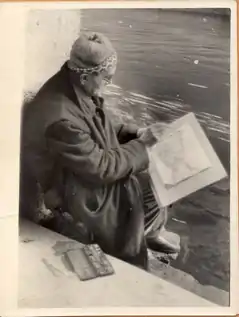
Death
The sculptor interrupted his artistic activity only briefly due to health problems in the early 1960s, when his left hand had temporarily been paralyzed after a stroke.
He died suddenly of a heart attack in the middle of the process of his work on July 14, 1963, in a small apartment in Malá Strana.
Work
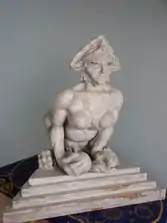
Plastic art
The early work of Leonard Rotter included sculpture portraits and busts of some of the leading Czech figures of the 19th and 20th centuries, such as professor of conservatory and harpist Václav Klička [cs] or the painter Láďa Novák [cs], published in the magazines Zlatá Praha 1924/1925[4] and 1925/1926,[5] respectively, as well as a portrait of the prominent Czech Egyptologist Professor František Lexa. He also created portraits of historical figures, such as the 17th century's Czech revolutionary leader Jan Sladký Kozina, and many others.[6]
Since the beginning of his artistic career, free creation has remained the core of his work - he created a number of smaller sculptures with philosophical themes such as Eternal Question, Life and Love, Desire, Twilight, and others. He also cooperated with a Czech lodge of Freemasons and created for them several works with the symbolism of order.[7]
His red marble (slivenec) statue of the Czech poet Karel Hynek Mácha, based on several designs created for the Society for the Restoration of Karel Hynek Mácha's Memorial,[8] was elevated and ceremonially unveiled in 1936 at the north coast of the Mácha Lake in Staré Splavy near Doksy, on the top of Jarmilina skála, the rock where Jarmila, one of the main figures in the poet's most famous work - Máj, jumped into the lake and ended her life. In 1939, however, the statue was torn down by Sudeten German Party (Sudetendeutsche Heimatfront of Konrad Henlein) during the fascist occupation of the area. Later, it was requested by Bělá pod Bezdězem and relocated further from the lake on top of Hůrka, where it remains until today, although the locality does not have the original context to the Society's intent.[9] The original design is now stored in the Museum in Česká Lípa.
In 1937, his 2.5 meter-high clay sculpture of a blacksmith was installed on the front of the house of a famous Czech engineer, Emil Kolben, at his residence in Břevnov at the street Na Vypichu (today's Bělohorská No. 1202) . The statue was destroyed during the reconstruction of the house in 1979.[1][10]
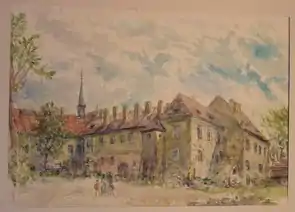

Fine art and watercolours
In the late thirties (1930s), Leonard Rotter embraced the technique of watercolour, as the demand of plastic art generally declined due to the difficult war times.[11] His watercolour paintings mostly depicted various alleys and monuments of Prague. He dedicated many years to create paintings of the Convent of St. Agnes.[1]
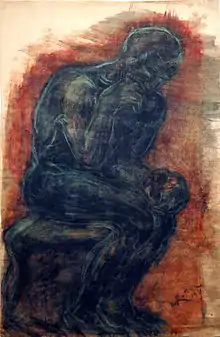
Legacy
František Dvořák, Czech art historian, about Leonard Rotter at the exhibition of his watercolour paintings of Malá Strana and Hradčany districts, in 1957 at Malostranská beseda:
"… He knows both districts with his heart, not just with his eyes, he can depict them internally, not just with his technique, he knows his topics for several decades and he likes them".[11]
Exhibitions
Collective exhibitions
- First comprehensive exhibition of sculptures of Leonard Rotter was held in 1936 at the Clam-Gallas Palace together with painter Oskar Rex.
Individual exhibitions
- 1940, Beaufort in Jungmannova Street, Prague.
- 1940, Sculpture studio in Hellichova Street in Malá Strana, Prague.
- In 1957, an exhibition titled Malá Strana and Hradčany in the work of Leonard Rotter took place in Malostranská beseda, where the author first exhibited his watercolors, which had been created since the late 1930s.
- In December 1963, collective exhibition of work of Leonard Rotter was held in Prague at the Institute of Biology of the Czechoslovak Academy of Sciences. Opening word was taken by František Dvořák, followed by complementing chamber music presented in live act by trio with František Xaver Thuri. At this exhibition, the bronze patinated sculpture Globus, representing symbols of scientific disciplines and the sun, which reinforces the harmonious vision of humanity endowed with love and wisdom for the future, was presented for the first time.
- 2005, cultural centre in Dobříš (a synagogue in the past).[12]
- In 2011, an exhibition of Leonard Rotter's aquarelles depicting Prague Kampa quarter was held in Komunitní centrum Kampa[13]
- 2015, Gallery of Česká Lípa, Memorial of K. H. Mácha, Doksy[14][8]
- 2016, Horácká galerie, Nové Město na Moravě.[15][3]
Selection of works
Desire, 1940s
Eternal question, 1940s
Life and Love, 1930s
Twilight, 1930s
Globus
K. H. Mácha, 1936
Blacksmith, 1937
Emil Zátopek
Convent of St. Agnes, 1959
Prague Venice, 1959
Funambulists at St. Castulus, 1949
References and sources
- 1 2 3 Rotter, Leonard; Blochová, Hana (2005). Akvarely, Leonard Rotter. Praha: TOMOS. ISBN 80-239-6173-X.
- ↑ "Leonard Rotter | abart". cs.isabart.org. Retrieved 2019-12-29.
- 1 2 3 4 Blochová, Hana (2005). Akvarely 1939—1963. Prague, Czech Republic: TOMOS. ISBN 80-239-6173-X.
- ↑ Otto, J. (1925-07-09). "Z kulturního světa". Zlatá Praha. 42 (45–46): 463–464. ISSN 1801-2493.
- ↑ Otto, J. (1926-08-05). "Z kulturního světa". Zlata Praha. 43 (25): 498–500. ISSN 1801-2493.
- ↑ "Rotter Leonard | Galerie malířství". www.galerie-malirstvi.cz. Retrieved 2019-12-29.
- ↑ Blochová, Hana (October 2005). "Dobříšské listy" (PDF). Život a dílo Leonarda Rottera.
- 1 2 "Leonard Rotter - výstava prací malíře a sochaře: Zastupitelstvo města: Doksy". www.doksy.com. Retrieved 2019-12-29.
- ↑ "V Bělé pod Bezdězem stojí "cestovní sochy" Karla Hynka Máchy. Mají pohnutý osud". Regiony (in Czech). 2017-03-06. Retrieved 2019-12-29.
- ↑ "Komunitní centrum Kampa". retro.kckampa.eu. Retrieved 2019-12-31.
- 1 2 "Horácká galerie v Novém Městě na Moravě otevře výstavu Leonarda Rottera - okres Žďár nad Sázavou". zdar-nad-sazavou.regiony24.cz. Retrieved 2019-12-31.
- ↑ "Dobříšské listy" (PDF).
- ↑ "Komunitní centrum Kampa". retro.kckampa.eu. Retrieved 2019-12-29.
- ↑ "Invitation to exhibition in Doksy, Memorial of K. H. Mácha".
- ↑ s.r.o, Antee. "vernisáž výstavy Leonard Rotter - akvarely, sochy | Horácká galerie v Novém Městě na Moravě". www.horackagalerie.cz (in Czech). Retrieved 2019-12-29.
External links
Leonard Rotter - akvarely a sochy, Horácká galerie, Youtube video